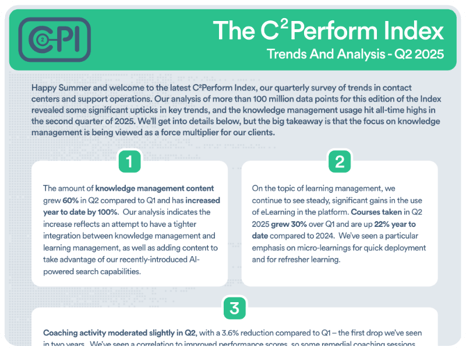If there’s one thing we hear about from all our clients, it’s the ongoing challenge in finding, getting and keeping the best possible workforce. This is especially true now: People are changing jobs more frequently (or thinking about it), demand for good employees is at historical highs and demands to deliver on a company’s customer experience (CX) promise have never been higher. Plus, upward pressures on pay make each hiring decision that much more critical.
This means that companies have to work harder than ever before to keep their employees engaged. Gallup coined the term “engaged employee” to refer to workers who are emotionally invested in their work environment and persist at tasks through thick and thin. The main reason employee engagement demands your attention: In companies with engaged teams outperform their counterparts who do not have good levels of engagement.
So what is it about highly-engaged employees that helps a company so much versus those who are not engaged or actively disengaged? The benefits of engaging the workforce will come as no surprise to any leader. Engaged employees help companies maintain goals by showing initiative, taking ownership of their roles, working towards reaching business objectives and completing assigned tasks on time. The net result is better profitability and intrinsic job satisfaction – which means lower turnover – because engaged workers perform better overall than non-engagers do. There are fewer mistakes, greater productivity and higher customer satisfaction. Engaged employees make better team members because they lean in to positive interactions with each other; they are more willing to help out their coworkers than those who aren’t engaged or actively disengaged would be.
Engaging workers is also good for your teams on a personal level. The engagement of employees leads to increased productivity and job satisfaction, which provides a sense of purpose for the employee—they feel like they are contributing something useful to an organization that needs them. This also leads to greater job security in the employee’s mind. Engaged employees are proactive as well; they actively seek out new opportunities and provide suggestions for improvements at their jobs, which makes them more valuable members of a team than those who aren’t engaged or disengaged would be.
We work with some great companies, and here are four employee engagement strategies we’ve observed that work for companies with engaged teams:
1. They set and communicate clear goals, provide feedback, and recognize their teams.
If employees don't know what the company is trying to achieve, they can't be expected to help achieve it. Setting and communicating clear goals is one of the most important things a company can do to keep its employees engaged. Employees need clarity about their role in achieving the organization's goals, and they need to be kept up to date on how their work is contributing to the organization's success. Setting clear and achievable goals is also a key way of assessing the performance of both employees and managers.
Regular feedback helps keep everyone on track, so use communications tools to ensure that people understand how they're doing at achieving their short-term objectives while moving towards longer term ones as well. A good employer recognizes and rewards employees' performance. (By the way, it's very important to remember that not all rewards are the same; some will have more impact than others on both employee engagement and retention.)
2. They provide opportunities for growth and learning.
Employees want to know that they are valued members of the team, and one way to show them this is by providing opportunities for growth and learning. When employees feel that the company is making an investment in them, they are more likely to be engaged in their work.
When it comes to intrinsic motivation, growth and development opportunities are a great tool for managers. Investing time in developing employees can help you retain top talent and build your bench of future leaders. Finally, giving employees opportunities to grow and learn is a great way to show that you value their contributions.
A separate note: Micromanagement stifles autonomy and can prevent growth and learning. Good managers know when to take their hands off the wheel and let their subordinates flex their creative muscles. Employees who feel like they’re empowered and have a chance to prove themselves will be more likely to go above and beyond than someone who feels like they’re being scrutinized at every turn.
3. They encourage team building.
Employees need to feel like they are part of a team to be engaged in their work. Even though this it’s harder to pull off a team lunch or happy hours or participating in charitable events, companies are still finding ways to build teamwork and camaraderie. Although the work environment is different, companies that win at engagement still prioritize teamwork and find ways to make it happen. Things like online contests, virtual happy hours, icebreakers and lunch-and-learn sessions can have a huge impact and build a stronger team.
When employees are working towards a common goal, they feel that their work is more valuable and something larger than themselves. They also develop connections with each other in the process of working together as a team to achieve this objective. These relationships can yield very beneficial results – shared vision, willingness to support a teammate, stronger commitment to goals and more.
The other thing we see consistently in engaged companies is an environment with leadership that has integrity, honesty, trustworthiness and accountability. Employees need to know they are working in a place where their efforts are valued. They need leadership that is transparent in their actions as well as truthful with them about the company's financial health or performance.
That greater transparency equals fewer surprises for employees. They also tend to feel more secure about their job and stay longer if they feel like they’re part of something bigger than just themselves and a paycheck.
4. They encourage communication and feedback.
Employees need to feel comfortable communicating with their managers if they want to be engaged in their work. Managers should encourage two-way communication by asking employees for input on decisions that affect them and by providing feedback on their work.
Plus, leaders in these successful companies share a similar trait: They’re approachable. Employees need to feel comfortable approaching their managers with questions and concerns, and managers need to be timely and clear with their responses. There’s nothing worse than a question or request falling into a vacuum, never to be seen again. For an employee, this is the ultimate “you don’t care” moment.
Engaged employees are motivated to help colleagues and customers, and the ripple effect of this can have a huge positive effect on an organization.
The takeaway
Employee engagement is key to the success of any organization. These four employee engagement strategies are a good starting point, and you can tailor them to fit your company’s needs and culture. We see these traits – or versions of them – in companies with actively engaged teams.
How a company engages its employees will determine how successful it is. These four strategies can help any organization increase employee engagement, and they are things you can do today.
(By the way, we’d love to hear your thoughts and ideas about how you’ve improved employee engagement in your company. Drop us a line at info@c2perform.com and include Engagement in the subject line. We’ll share the best input with our readers in a future blog.)
 English
English Español
Español





.png?height=350&name=Untitled%20(300%20x%20175%20px).png)



